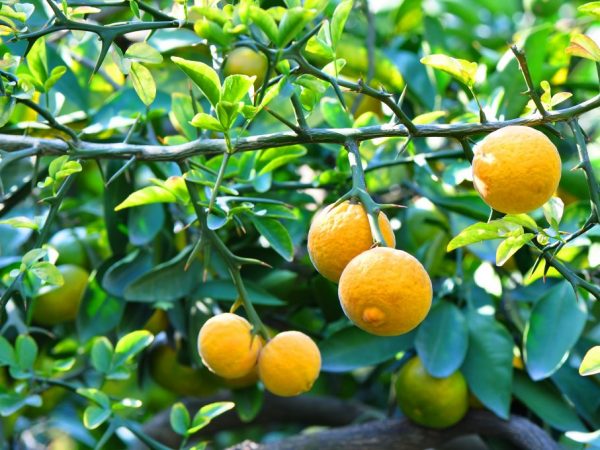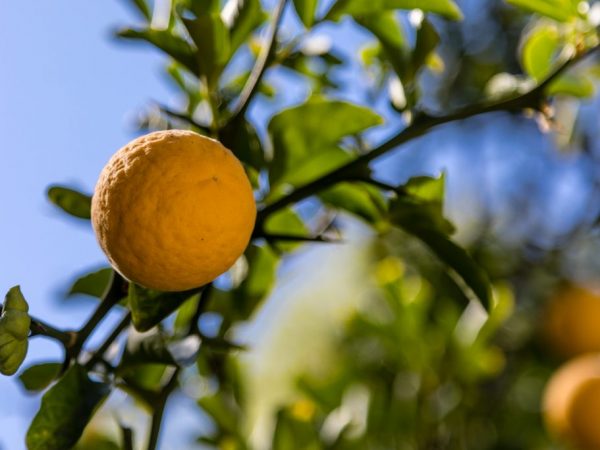Wild lemon and its uses
Wild lemon in appearance and taste is close to the classic garden culture - ordinary lemon.

Wild lemon and its uses
Botanical characteristic
The wild lemon belongs to the rue family, the citrus genus. Hybrid varieties with citron and mandarin are possible.
The wild lemon shrub is small in size, up to 3-6 m in height. In the leaf axils, thorns grow 1 cm long. The foliage is oval, its length is up to 11 cm, with a smooth shiny surface, attached to the stems on small, up to 1 cm, petioles equipped with wings.
The fruit is round or ovoid, slightly larger than a classic lemon, about 6-7 cm long and 3-4 cm in diameter. At the stage of technical ripening, the skin color of the fruit is yellow.
Due to the specific peel, the plant has another name - rough-skinned lemon.
The peel of wild lemon is rough and warty. The mesocarp (mesocarp) is white, up to 1 cm thick. The juice sacs of the pulp inside the fruit are colorless or pale yellow, have a sour taste with a bitterness characteristic of lemon.
Place of growth
The supposed homeland of the wild lemon is South Asia, in particular the wild forests of India and China.
Today, the plant is cultivated in tropical and subtropical areas, especially in southern Asia, including Pakistan, Cambodia and Bangladesh, and in Latin America: Brazil, Peru, Ecuador and Venezuela.
Chemical composition and practical application
The chemical composition of 100 g of wild lemon contains:
- vitamins, including 1.9 μg RE, A, 0.01 mg beta-carotene, 0.07 thiamine B1, 0.3 mg riboflavin B2, 0.3 mg pantothenic acid B5, 0.06 mg pyridoxine B6, 7 μg of folates B7, 37 mg of ascorbic acid, 0.2 mg of alpha-tocopherol E, 0.2 mg of PP;
- macronutrients, including 162 mg of potassium; 9 mg sulfur, 41 mg calcium, 5 mg chlorine, 11 mg magnesium, 22 mg phosphorus, 12 mg sodium,
- trace elements, including 2 μg molybdenum, 163 μg boron, 0.03 mg manganese, 11 μg fluorine, 0.5 mg iron, 251 μg copper, 0.15 mg zinc,
- 1 g dextrose
- 1.2 g sucrose,
- 1 g fructose.
Caloric content of 100 g of product - 41 kcal, including:
- 0.8 g protein
- 0.2 g fat
- 2 g carbohydrates
- 5.3 g of organic acids,
- 2.1 g dietary fiber and readily soluble fiber
- 86.9 g of water
- 0.4 g of ash substances.
Practical use

The fruits are used in cooking
Wild lemon has found many uses.
Cooking
The fruits are used in a similar way to the use of classic citrus, including in cooking as a seasoning and in the preparation of sweet dishes and pastries. After heat treatment, it is consumed in its pure form. Due to the high content of bitter essential oil, wild lemon cannot be consumed without heat treatment.
Gardening and landscaping
Wild lemon is used for vegetative propagation of varietal varieties of lemons in the process of grafting as a rootstock.
In landscaping, the plant is grown as a hedge.
ethnoscience
The fruit is widely used to treat a number of diseases.
Immunity
The plant saturates the body with ascorbic and folic acids, organizes normal hematopoiesis and increases resistance to colds.
Teeth
Organic acids and essential oil act as means for fresh breath and restoration of oral microflora, slow down the development of caries, have whitening properties, and are part of many toothpastes.
Skin covering
Wild lemon is an effective treatment for the epidermis, including acne, dryness and flaking. It also promotes cell regeneration.
Gastrointestinal tract
The fruit neutralizes increased acidity, contributing to the activation of digestion processes, breaks down undigested food residues. Thanks to the dietary fiber contained in the composition, it is useful for colitis and rectal ulcers.
Blood vessels
Lemon cleanses the blood of toxins, enhancing blood circulation through the vessels, and increases the level of hemoglobin.
Heart muscle
The plant prevents the development of the deposition of fat cells that adversely affect the normal functioning of the heart muscle.
Bone
Lemon acts as a source of calcium, replenishing its lack in bone tissue, reducing the risk of joint diseases.
Normalization of the general condition
Thanks to the B vitamins in the chemical composition, wild lemon has a beneficial effect on the general condition, increasing efficiency and acting as a tonic.
Conclusion
Wild lemon in appearance, taste and quality characteristics is close to the classic citrus. It has found wide application in cooking and traditional medicine.


